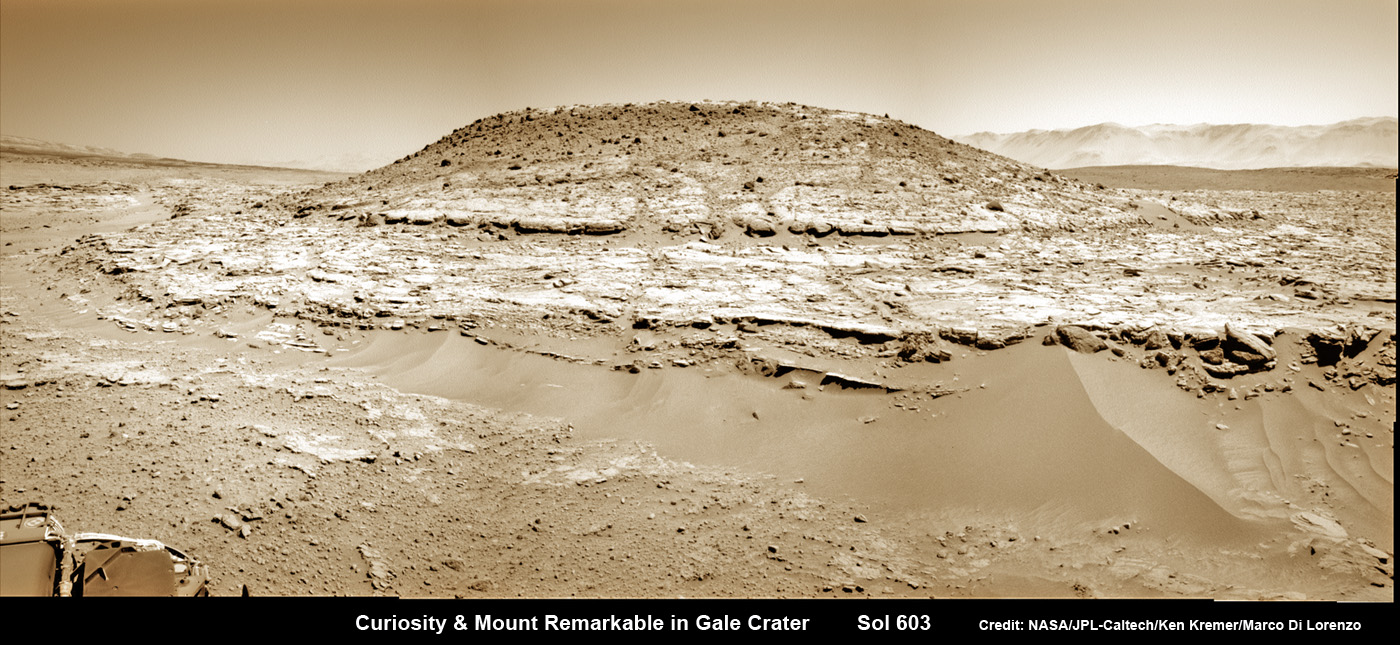
Featured on APOD – Astronomy Picture of the Day on May 7, 2014
NASA’s car-sized rover Curiosity has successfully bored deep into the enticing bumpy textures of a sandstone slab at “Kimberley” and collected powdery samples from the interior of the Red Planet outcrop target dubbed “Windjana” earlier this week, on Monday, May 5, Sol 621.
The 1-ton robot is now processing the precious Martian rocks for delivery to her miniaturized chemistry labs to unlock clues about habitability on the alien world. See our photo mosaics above and below.
“Windjana” is only the third rock target Curiosity has acquired samples from on the Red Planet since the unprecedented sky crane landing on Aug. 6, 2012.
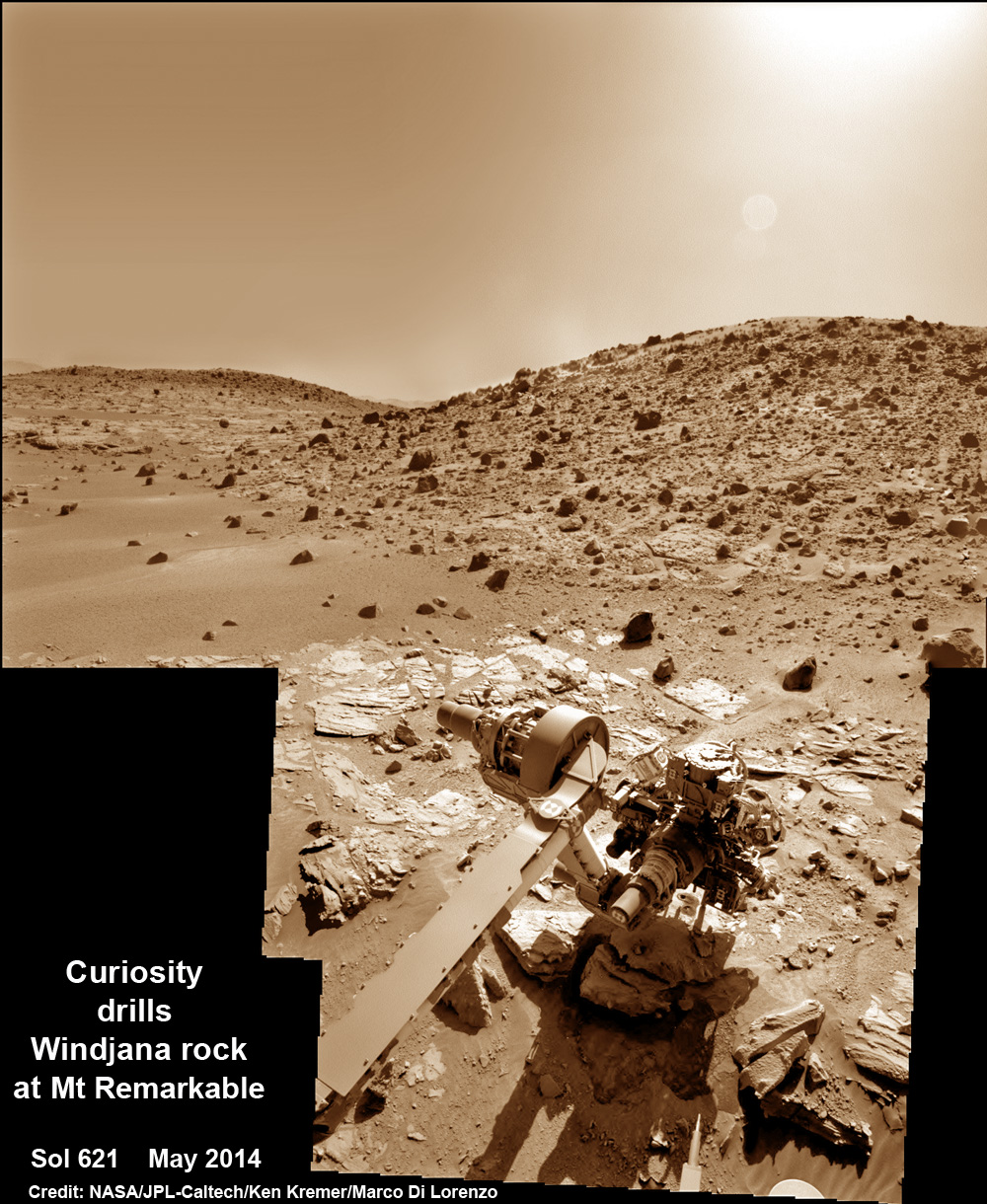
It’s also Curiosity’s first drilling campaign in a year since departing the ancient lakebed region at “Yellowknife Bay” last summer, at the start of her epic 10-kilometer-long (6-mile) trek to towering Mount Sharp, the primary destination of the mission.
“Windjana” also counts as the first sandstone rock being analyzed. Both prior drill samples came from mudstone rock outcrops.
Images transmitted back to Earth on Tuesday, May 6, Sol 622, confirmed that the robot’s hammering drill positioned at the end the 7-foot-long (2-meter) arm had accomplished the programmed task precisely as planned.
Furthermore, there was no damage to the drill.
The fresh, full-depth hole at “Windjana” is clearly visible in the images and measures 0.63 inch (1.6 centimeters) in diameter and about 2.6 inches (6.5 centimeters) deep.
The full-depth hole is just a few centimeters away from the much shallower “mini-drill” test hole bored initially at Windjana on April 29 to determine its suitability for achieving the science requirements needed prior to delivery to the pair of onboard chemistry labs in the rover’s belly, SAM and CheMin.
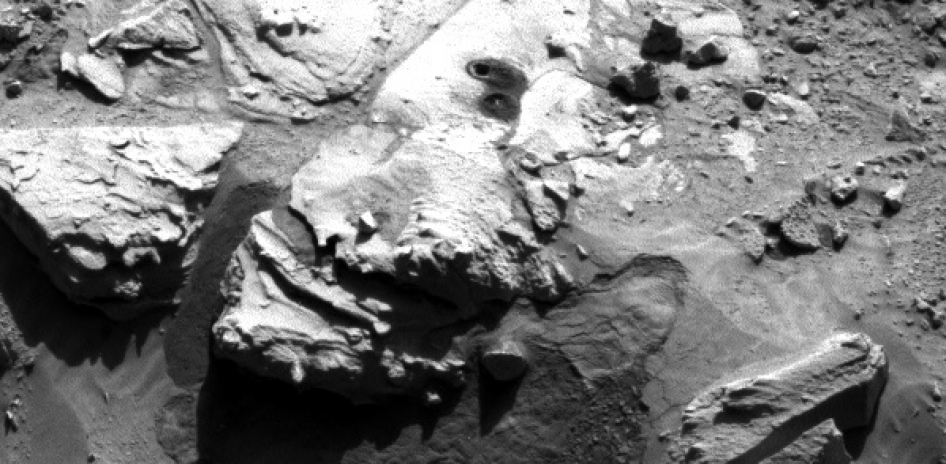
The “Windjana” outcrop is located at the base of the 5-meter-tall (16-foot) butte named “Mount Remarkable” located at “The Kimberley Waypoint,” a science stopping point reached by the rover in early April 2014.
To see the gorgeous terrain being inspected by Curiosity today, check out our photo mosaics of “Kimberley” and “Mount Remarkable” herein—created by the image processing team of Ken Kremer and Marco Di Lorenzo.
Our image of “Mount Remarkable” was also featured at Astronomy Picture of the Day (APOD) on Wednesday, May 7, 2014, here.
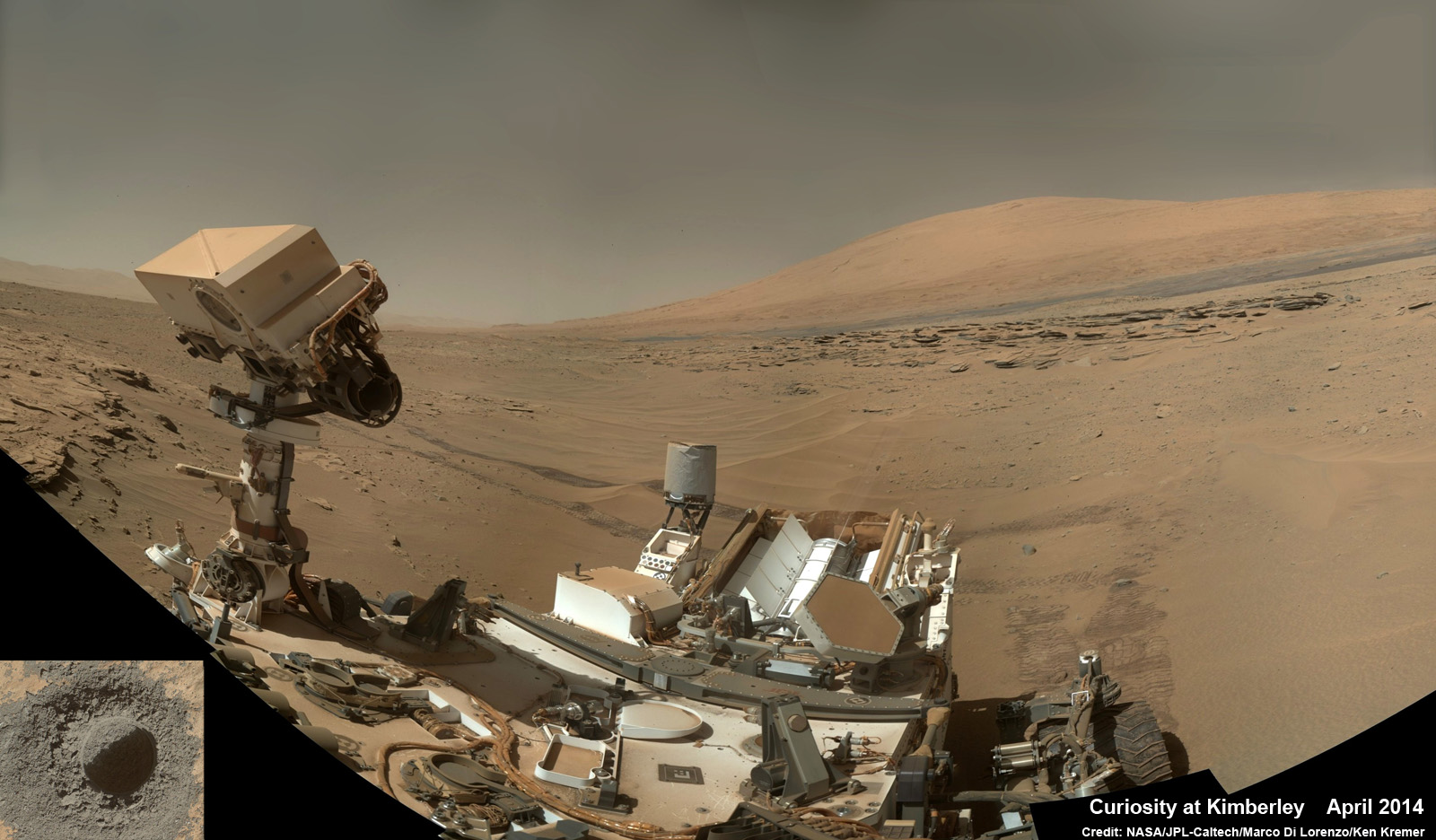
“Mount Remarkable” is named after a national park in South Australia.
“Windjana” is named after a gorge in Western Australia.
The residual pile of drill tailings left behind is much darker in color compared to the other two drill campaigns at the “John Klein” and “Cumberland” target in Yellowknife Bay. And also completely different from Mars ubiquitous red color seen most everywhere else.
“The drill tailings from this rock are darker-toned and less red than we saw at the two previous drill sites,” said Jim Bell of Arizona State University, Tempe, deputy principal investigator for Curiosity’s Mast Camera (Mastcam).
“This suggests that the detailed chemical and mineral analysis that will be coming from Curiosity’s other instruments could reveal different materials than we’ve seen before. We can’t wait to find out!”
The science team chose Windjana for drilling “to analyze the cementing material that holds together sand-size grains in this sandstone,” says NASA.
“The Kimberley Waypoint was selected because it has interesting, complex stratigraphy,” Curiosity Principal Investigator John Grotzinger, of the California Institute of Technology, Pasadena, told me.
“The Windjana material was transferred to the CHIMRA [sample processing] system for CheMin analysis,” wrote science team member John Bridges in a mission update.
The material will first be pulverized and sieved prior to delivery to the Chemistry and Mineralogy instrument (CheMin) and the Sample Analysis at Mars instrument (SAM) for chemical and compositional analysis.
The tailing will also be analyzed by ChemCam and the APXS mineral spectrometer, reports Bridges.
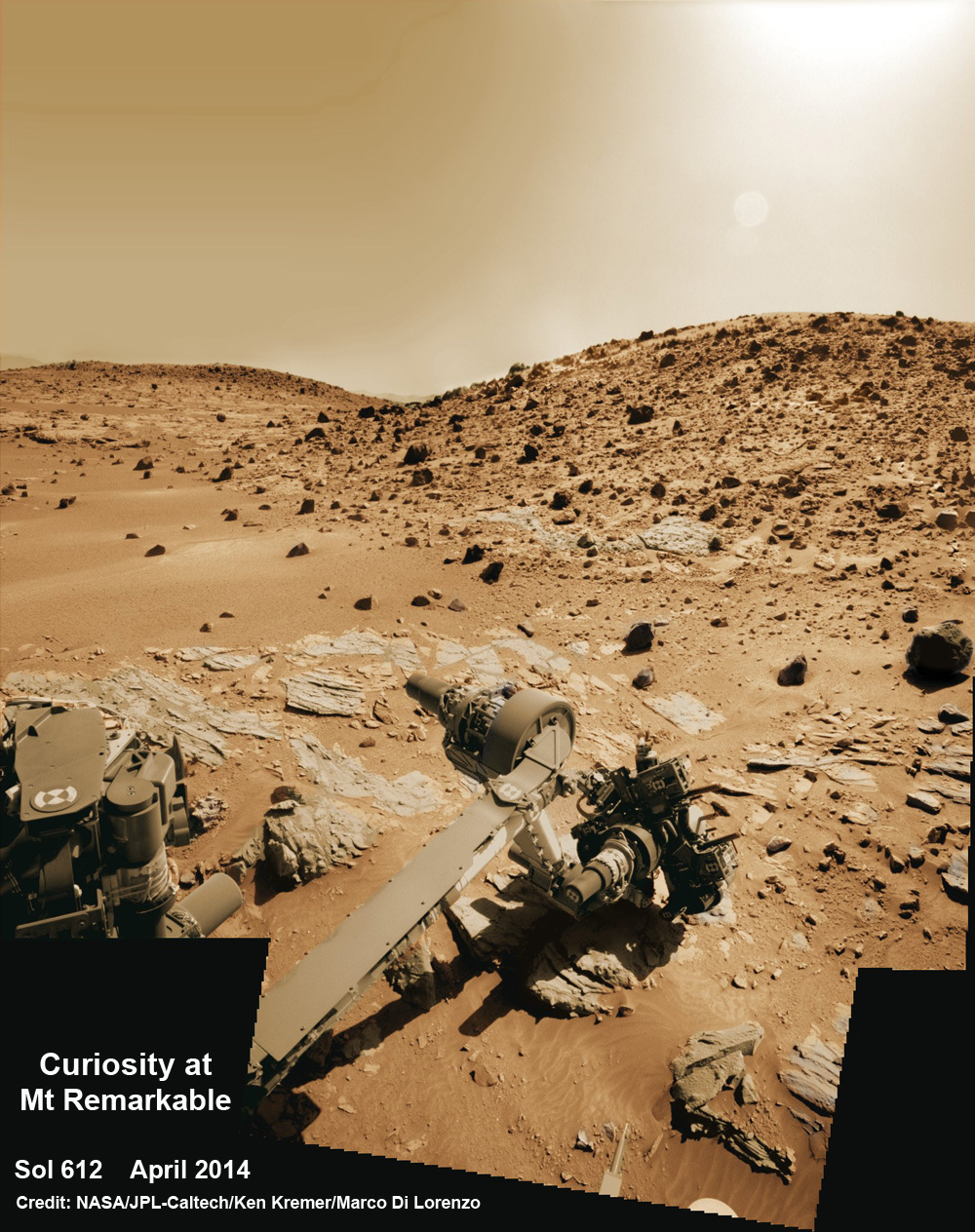
“There are also some clasts or perhaps nodules around the drill area, it is important to get a combination of the composition of the material around the drill hole to compare with the mineralogy determined by X-ray diffraction,” Bridges noted.
Kimberley lies about halfway along the path to Mount Sharp.
Windjana is about 2.5 miles (4 kilometers) southwest of Yellowknife Bay.
The sedimentary foothills of Mount Sharp reach some 3.4 miles (5.5 km) into the Martian sky and is the robot’s ultimate destination inside Gale Crater because it holds caches of water-altered minerals. Such minerals could possibly indicate locations that sustained potential Martian life forms, past or present, if they ever existed.
Curiosity departed the ancient lakebed at the Yellowknife Bay region in July 2013, where she discovered a habitable zone with the key chemical elements and a chemical energy source that could have supported microbial life billions of years ago—and thereby already accomplished the primary goal of the mission.

Curiosity still has about 4 kilometers to go to reach the base of Mount Sharp sometime later this year, but must first survive the unavoidable passage through a potentially treacherous dune field.
To date, Curiosity’s odometer totals 3.8 miles (6.1 kilometers) since touchdown inside Gale Crater on Mars in August 2012.
The six-wheeled robot has some 4 kilometers to go to reach the base of Mount Sharp.
She has snapped over 147,000 images.
And the new MAVEN and MOM orbiters from NASA and India are streaking toward the Red Planet for orbital insertion in September 2014.
Stay tuned here for continuing updates.
Want to keep up-to-date with all things space? Be sure to “Like” AmericaSpace on Facebook and follow us on Twitter: @AmericaSpace




Incredible images for human eyes along with intriguing analysis of the Martian surface for all of us to share! Each new report is eagerly anticipated as we learn more about the Red Planet.